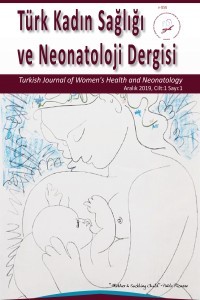Gebeliğin Birinci ve İkinci Trimesterinde Görülen Vajinal Kanama ile Kötü Obstetrik Sonuçlar Arasındaki İlişki
Abortus imminens, hematom, gebelik, obstetrik sonuçlar
The Relationship Between Vaginal Bleeding in The First and Second Trimester of Pregnancy and Poor Obstetric Outcomes
Abortus imminens, hematoma, pregnancy, obstetric results,
___
- Simpson JL, Mills JL, Holmes LB et al. Low fetal loss rates after ultrasound-proved viability in early pregnancy. JAMA 1987; 258: 2555–2557.
- Yıldız Ç, et al. First-trimester sonographic diagnosis of massive subchorionic hemorrhage: a case report. Cumhuriyet Medical Journal. 2009; 31(1): p. 71-74.
- Axelsen SM, Henriksen TB, Hedegaard M, Secher NJ. Characteristics of vaginal bleeding during pregnancy. Eur J Obstet Gynecol Reprod Biol. 1995;63:131–134.
- Weiss JL, Malone FD, Vidaver J, et al. Threatened abortion: a risk factor for poor pregnancy outcome. a population-based screening study. Am J Obstet Gynecol 2004; 190: 745–750.
- Sharami S.H, et al. The relationship between vaginal bleeding in the first and second trimester of pregnancy and preterm labor. Iran J Reprod Med. 2013;11(5):385-390.
- Karim SA, Bakhtawar I, Butta AT, Jalil M. Effects of first and second trimester vaginal bleeding on pregnancy outcome. J Pak Med Assoc. 1998;48:40–42.
- Bang S.W, Lee S.S. The factors affecting pregnancy outcomes in the second trimester pregnant women. Nutr Res Pract 2009; 3(2):134-140.
- Laraia BA, Siega-Riz AM, Gunderson C, Dole N. Psychosocial factors and socioeconomic indicators are associated with household food insecurity among pregnant women. J Nutr 2006;136:177–182.
- Nanda K, Lopez L.M, Grimes D.A, Peloggia A, Nanda G. Expectant care versus surgical treatment for miscarriage. The Cochrane database of systematic reviews, 2012(3), CD003518.
- Bever A.M, Pugh S.J, Kim S, et al. Fetal Growth Patterns in Pregnancies With First-Trimester Bleeding. Obstet Gynecol 2018; 131(6):1021-1030.
- Velez Edwards D.R, Baird D.D, Hasan R, Savitz D.A, Hartmann K.E. First-trimester bleeding characteristics associate with increased risk of preterm birth: data from a prospective pregnancy cohort. Hum Reprod 2012; 27(1): 54–60.
- Harville E.W, Wilcox A.J, Baird D.D, Weinberg C.R. Vaginal bleeding in very early pregnancy. Human Reproduction 2003;18(9):1944-1947.
- Hasan R, Baird D.D, Herring A.H, Olshan A.F, Jonsson Funk M.L, Hartmann K.E. Association between first-trimester vaginal bleeding and miscarriage. Obstet Gynecol 2009;114(4):860-867.
- Weiss J.L, Malone F.D, Vidaver J, et al. & FASTER Consortium Threatened abortion: A risk factor for poor pregnancy outcome, a population-based screening study. Am J Obstet Gynecol 2004;190(3):745-750.
- Towers C.V, Burkhart A.E. Pregnancy outcome after a primary antenatal hemorrhage between 16 and 24 weeks’ gestation. Am J Obstet Gynecol 2008;198(6):684.e1-5.
- Magann E.F, Cummings J.E, Niederhauser A, Rodriguez- Thompson D, McCormack R, Chauhan S.P. Antepartum bleeding of unknown origin in the second half of pregnancy: a review. Obstet Gynecol Surv 2005;60(11):741-745.
- Bhandari S, Raja E.A, Shetty A, Bhattacharya S. Maternal and perinatal consequences of antepartum haemorrhage of unknown origin. BJOG 2014;121(1):44-50.
- Ball RH, Ade CM, Schoenborn JA, Crane JP. The clinical significance of ultrasonographically detected subchorionic hemorrhages. Am J Obstet Gynecol 1996;174(3):996-1002.
- Pedersen J.F and M. Mantoni M. Large intrauterine haematomata in threatened miscarriage. Frequency and clinical consequences. Br J Obstet Gynaecol 1990;97(1):75-77.
- Başlangıç: 2019
- Yayıncı: Sağlık Bilimleri Üniversitesi Etlik Zübeyde Hanım Kadın Hastalıkları Eğitim ve Araştırma Hastanesi
Yıldız AKDAŞ REİS, Arife AKAY, Büşra ŞAHİN, Seval YILMAZ ERGANİ, Salim ERKAYA
Fetal Anomali Nedeniyle Gebelik Sonlandırılması Sorunları
Fatma OZLU AKKUŞ, Canan TAPKAN, Müjde Can İBANOĞLU, Nagihan CENGAVER, Elif Gül YAPAR EYİ
Yenidoğanda İzole Laküner Kafa Deformitesi
Ayşen Sumru KAVURT, Nihal DEMİREL, Betül CUNİ, Yasemin TASCI YILDIZ, Ahmet Yağmur BAŞ
Caner KOSE, Büşra KÖRPE, Vakkas KORKMAZ, Yaprak USTUN
Münevver AKSOY, Gülsemin ERTÜRK ÇELİK, Yaprak USTUN
İlk Trimesterde Bradikardik Olan Fetuslar Terme Ulaşıyor Mu?
Seval YILMAZ ERGANİ, Yıldız AKDAŞ REİS, Susam ÇELİK, Müjde Can İBANOĞLU, Okan AYTEKİN, Metin ALTAY, Leyla MOLLAMAHMUTOĞLU, Cantekin İSKENDER
Tuba MEMUR, Nagihan CENGAVER, Canan TAPKAN, Müjde Can İBANOĞLU, Burçin SALMAN ÖZGÜ, Tayfun GÜNGÖR
